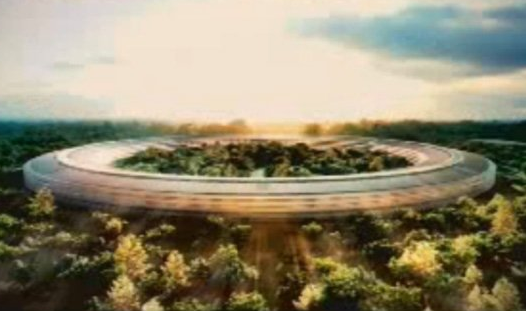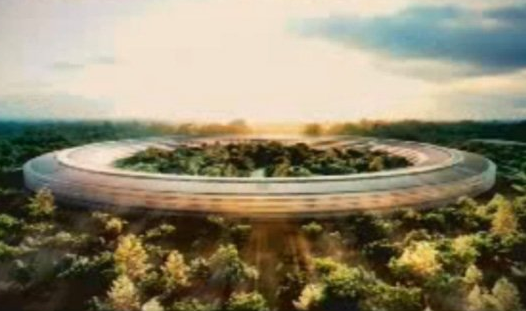 Back to the future in the Apple spaceship.Screenshot: Apple via YouTube
Back to the future in the Apple spaceship.Screenshot: Apple via YouTube
The old-school suburban office park seems to be having a midlife crisis.
A special report in Crain’s about Chicago-area businesses such as Sears, AT&T, and Sara Lee looking to relocate from the suburbs to the urban core — along with the news that Swiss megabank UBS may be abandoning Stamford, Conn., to move back to Manhattan — has prompted a flurry of responses around the urbanist blogoverse.
Meanwhile, two of the American companies nearly universally hailed as forward-thinking — Facebook and Apple — are betting their futures on super-fancy suburban complexes.
There are a lot of contradictions here.
On one side are commentators who say there is a huge generational shift happening.
Kaid Benfield of the Natural Resources Defense Council gave an approving nod to the news from Chicago:
Now, just as the tide has turned against large-lot suburban residential subdivisions, corporations are moving back into town (or, as in the case of Dublin, Ohio, doing everything they can to make their suburb more urban in character). The best and the brightest of the rising labor force, it turns out, don’t care to live and work in sprawl.
Writing at The New Republic‘s The Avenue blog, Christopher Leinberger of the Brookings Metropolitan Policy Program opines that employees are driving these corporate decisions:
The millennial generation is demanding it. Highly educated young workers, the life’s blood of many industries, have been flocking to center cities in recent years. Trying to recruit this talent to Stamford, Conn., or Hoffman Estates, Ill. is exceedingly difficult. They are voting with their feet for a hip, high-density walkable lifestyle and a reverse commute to the ‘burbs is not in the cards for most of them.
The companies moved out to the suburbs to attract their baby boomer parents, raising their kids in suburban isolation. The millennials are doing what many generations have done in the past; they have rejected how they were raised. This once again shows that building a high quality residential base will lead to the attraction of jobs…only this time it is back to the future.
A few months back, I wrote about a Michigan business owner who made the same point, saying that he could not lure talented young people to the upscale sprawl suburb of Troy, Mich., no matter how much he paid them. He cited exactly the same factors as Leinberger does. The people he wants to hire don’t want to live in miles of sprawl.
Eric Jaffe at The Infrastructurist is skeptical of Leinberger’s reasoning in the case of UBS, pointing out that Stamford is the eighth-largest city in New England, and, as such, “hardly worthy to be called a suburb.”
But I’d have to agree with several of Jaffe’s commenters, who note that despite its size and relative density, Stamford feels pretty darn suburban. The face that it shows to the world, along the entry points of I-95 and commuter rail, is one of parking structures and impenetrable glass façades. It is a city in suburban corporate office park’s clothing.
Jaffe goes on to pose an excellent question, however, about what exactly urbanism advocates are supposedly trying to accomplish here:
I may be wrong here, but it would seem that the point of the walkable city movement is not to abandon the Stamfords of America in a race to New York, but rather to bring a little more of New York to places like Stamford.
The problem is that this is so much more easily said than done. With all of the talk about suburban retrofitting, we have yet to see a community designed as an auto-dependent suburb that has been transformed into the kind of dynamic urban environment that is increasingly recognized as an engine of creativity, by economists such as Edward Glaeser and urban theorists such as Richard Florida.
All of which makes you wonder if the two hottest names in American business right now, Facebook and Apple, are swimming against the generational tide, and what that means for their creative future.
The styles of their campuses are different. But their disconnection from the community, and the implicit belief that they can function as autonomous quasi-cities while retaining their creative edge, are the same.
Facebook wants to make its new office park in suburban San Mateo County, Calif., into a simulacrum of a walkable urban village. (Twitter, in contrast, fought hard to stay in downtown San Francisco, winning tax breaks from the city and sparking hope for a new high-tech business district downtown. The comany specifically cited the desire of employees to live, work, and be involved in the urban community.)
Meanwhile, Apple’s Steve Jobs just proposed the construction of an enormous new headquarters in Cupertino, Calif., that he likened to a spaceship. Here’s Treehugger’s Lloyd Alter opinion about that project:
So what is one to say about Apple’s proposed new headquarters, a building with no corners and no streets? That is it anti-urban, anti-social, anti-environmental and probably anti-Apple. And, that it could signal the end of Apple as a creative juggernaut. Apple has done so much for design, crafting beautiful objects that have changed our expectations of what electronics should look like and how they should work. Their stores have reinvented retailing.
But I have serious issues with the design of this project. It turns its back on its community. It addresses the street with a wall of parking garages. … It tosses everything we ever knew about community out the window.
Designed by starchitect Norman Foster, the new 150-acre Apple campus will be the work home of 12,000 people, and it promises to incorporate an energy center to power the facility (fuel so far unspecified, as far as I can tell) and 80 percent landscaping. That green space is being gained at the expense of surface parking, but not because people won’t be driving. The parking is just going underground.
Apple and Facebook have decided, quite consciously, to insulate themselves from the ferment of urban life that appeals to so many of the most creative people in the United States today. Maybe they will be happy in their custom-made, self-contained bubbles. Or maybe down the road, they’ll be like one-time innovative giants such as Sears — looking longingly toward downtown.



